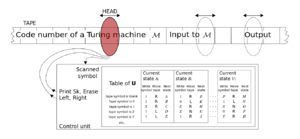Turing completeness (nonfiction): Difference between revisions
No edit summary |
|||
| Line 1: | Line 1: | ||
[[File:Universal Turing machine.svg|thumb|A [[Universal Turing machine]] '''U'''. '''U''' consists of a set of instructions in the table that can “execute” the correctly-formulated "code number" of any arbitrary [[Turing machine]] '''M''' on its tape. In some models, the head shuttles back and forth between various regions on the tape. In other models the head shuttles the tape back and forth.]]In computability theory, a system of data-manipulation rules (such as a programming language) is said to be '''Turing complete''' or '''computationally universal''' if it can be used to simulate any single-taped [[Turing machine]]. | [[File:Universal Turing machine.svg|thumb|A [[Universal Turing machine]] '''U'''. '''U''' consists of a set of instructions in the table that can “execute” the correctly-formulated "code number" of any arbitrary [[Turing machine (nonfiction)|Turing machine]] '''M''' on its tape. In some models, the head shuttles back and forth between various regions on the tape. In other models the head shuttles the tape back and forth.]]In computability theory, a system of data-manipulation rules (such as a programming language) is said to be '''Turing complete''' or '''computationally universal''' if it can be used to simulate any single-taped [[Turing machine (nonfiction)|Turing machine]]. | ||
== Description == | == Description == | ||
Revision as of 07:41, 3 June 2016

In computability theory, a system of data-manipulation rules (such as a programming language) is said to be Turing complete or computationally universal if it can be used to simulate any single-taped Turing machine.
Description
The concept is named after English mathematician Alan Turing.
A classic example is lambda calculus.
A closely related concept is that of Turing equivalence -- two computers P and Q are called equivalent if P can simulate Q and Q can simulate P.
According to the Church–Turing thesis, which conjectures that the Turing machines are the most powerful computing machines, for every real-world computer there exists a Turing machine that can simulate its computational aspects.
Universal Turing machine can simulate any Turing machine and by extension the computational aspects of any possible real-world computer.
Example
To show that something is Turing complete, it is enough to show that it can be used to simulate some Turing complete system.
For example, an imperative language is Turing complete if it has conditional branching (e.g., "if" and "goto" statements, or a "branch if zero" instruction.) and the ability to change an arbitrary amount of memory locations (e.g., the ability to maintain an arbitrary number of variables).
Since this is almost always the case, most (if not all) imperative languages are Turing complete if the limitations of finite memory are ignored.
Nonfiction cross-reference
Fiction cross-reference
External links
- Turing completeness @ wiki.karljones.com
- Turing completeness @ Wikipedia